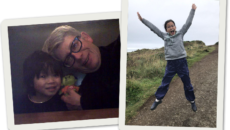The attachment cycle is as simple as it is profound. When it goes the way it’s supposed to, most parents simply do their job of parenting — and the child thrives. Over and over again, there is a pattern of need, arousal, gratification, and trust. Like drops of water on a tender baby plant, this constant cycle eventually makes a sturdy plant with beautiful flowers. Unfortunately, children adopted at older ages, from foster or institutional care, are not always tender plants waiting to be watered. Instead, they are often prickly cacti, with needles sharp enough to keep parents away. But even a cactus needs some water, just as a hurt child needs to experience the attachment cycle — including gratification — if he is to build trust.
It is difficult for most people to understand why such children reject what all children need — love and nurturing. The answer is simple: They learned early in life to trust no one. They learned that people leave you if you love them. Consider a four-year-old child whose adoptive home is his sixth placement. Now imagine that you were an adult who had had six divorces in four years. How eager would you be to jump into marriage number seven? Even if the new spouse seemed wonderful, and had a beautiful home, would you hesitate at all? Would the new spouse need to prove his trustworthiness? Would you counsel a friend in that situation to wait before entering a new relationship? The child’s rejection of nurturing is not personal. Although it feels that way, it would be directed at anyone trying to be the parent.
The challenge becomes how to nurture someone who repels nurturing, how to sneak in enough fun so that the little cactus will begin to bloom. Here are 25 ways to nurture a child who needs to learn how to accept love. Choose the ones that resonate for you.
Increasing Eye Contact
- Write an I-love-you message in shaving cream or soap on a mirror. Stand behind your child when she reads it. You may get a glance in the mirror. If not, you have still said, “I love you.”
- Play peek-a-boo with your child. Don’t assume that a newly adopted 10-year-old is too old to play peek-a-boo.
- Hide chocolate kisses. For each one the child finds, he must look in your eyes for five seconds and get a kiss from you before he can eat it.
- Put a sticker in your face right between your eyes. Don’t comment on it. The child will look at you and laugh — eventually.
- Look at each other and name the ways you are alike — you both have noses, freckles, brown eyes. Explore each other’s features.
Encouraging Touch
- Put a delightful-smelling lotion on your child and have him reciprocate. Talk about how you smell alike.
- Comb, brush, or braid your child’s hair.
- Have a family “group hug” every morning before you go your separate ways.
- Squeeze together on the couch to watch TV or a movie.
- Tickle him, but stop if he asks you to.
Moving in Sync with Your Child
- Blow bubbles. Chase them around to pop them.
- Rock together. If your child rocks to get to sleep, hold him and do it for him. If he’s too big to hold on your lap, buy a double rocker or swing on a porch swing together.
- Roll a ball back and forth. With an older child, toss a ball or a beanbag.
- Build something together — a block tower, a bird house, a model airplane.
- Walk to the mailbox with your child and mail a note to someone he misses — a former foster parent, a birth sibling.
Getting Warm and Cozy
- Pitch a play-tent in the living room. Let your child stay in it as long as he likes.
- Set up a card table. Put a blanket over it and play baby underneath, just you and your child.
- Put her gloves and scarf in the dryer for a few minutes to make them warm. Send her off to school with a wonderful, comfy feeling.
- Make or buy a soft, warm blanket to use while watching television, reading, or engaging in other quiet activities.
- Serve your child hot soup as an after-school snack.
Enhancing Communication
- Sit with your child and read a book you chose together, chapter by chapter, every day.
- Look in the mirror and make sad, mad, glad, or scared faces with the child in response to questions like: “How would a child feel if he lost his bicycle?” “How would a child feel if someone took his favorite toy?” “How would a child feel if he could eat a hot fudge sundae for breakfast?” “How would a child feel when he heard a ghost story?”
- Discuss where you would go if you could fly.
- Interview all of your family’s helpers — nurse, doctor, therapist, social worker — together and see who can name all of Disney’s Seven Dwarfs.
- Tell your child his adoption story—over and over again.
Adapted from Parenting the Hurt Child. Copyright 2002, 2009 by Gregory C. Keck and Regina M. Kupecky. Used by permission of NavPress. All rights reserved.



